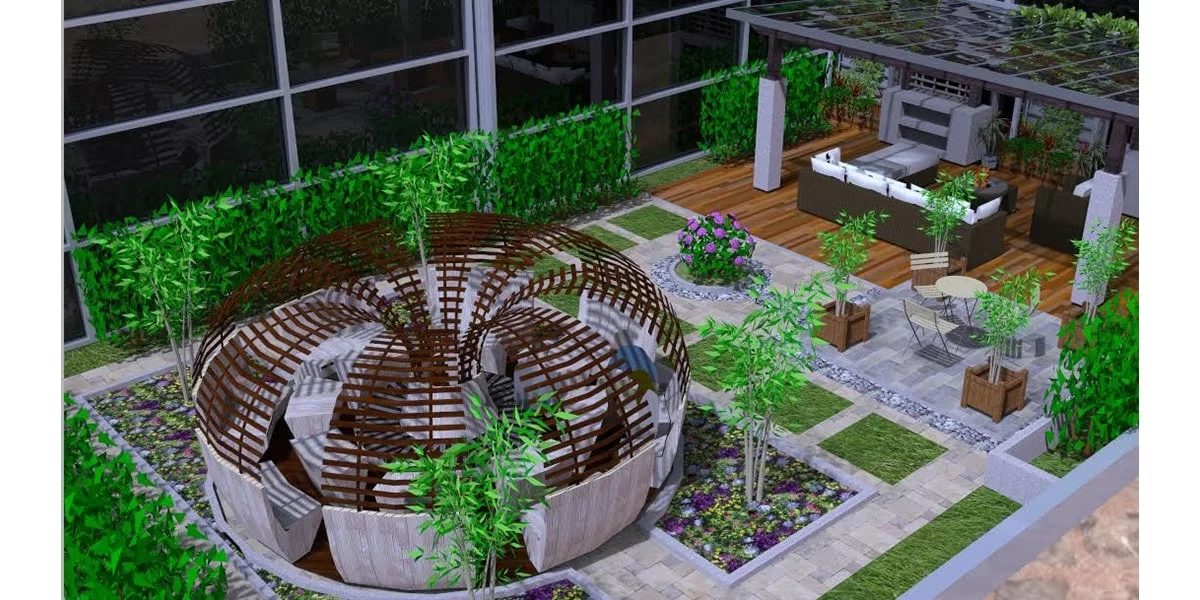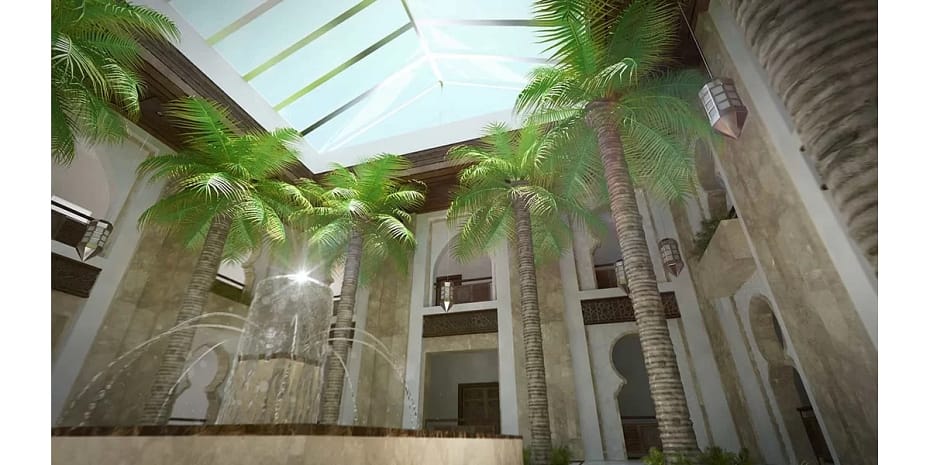The term “healthy green buildings” refers to buildings that take into account environmental impact and human health in their design and implementation.
Examples of environmental impacts include energy and water efficiency, building materials and greenhouse gas emissions.
While human health considerations include incorporating design features that proactively aim to positively impact the health of building occupants through strategies such as better ventilation systems to improve indoor air quality.
So far, it has been proven that green buildings around the world contribute to reducing greenhouse gas emissions and improving the health and well-being of their occupants compared to traditional buildings.
Sustainable design
Green building as a design approach emerged about twenty-five years ago as a result of the sustainability movement reaching the mainstream.
This has opened up a whole new market for design, architecture and technology.
Today, this industry is worth $1 trillion worldwide and is expected to expand rapidly.
If it wasn’t clear before the pandemic, it’s clear now:
The built environment has a huge role to play in building a healthier and more sustainable world,
from combating climate change to improving human health.
Lockdowns and isolation have given us a greater appreciation for the role our surroundings play in our health and well-being.
As we have seen, there is no choice between environmental health and human health – they are inseparable.
Amid the uncertainty of the past year, one thing is clear:
We will all return to work with new expectations about the buildings in which we live, learn, work and play.

Sanitary buildings
A few decades ago, people sat in cubicles all day, and smoking was largely tolerated in offices.
While today’s workplace looks very different as a result of the cultural shift brought about by increased awareness of the impacts of offices on the environment and human health.
The healthy building trend is an offshoot of the green building movement,
which is characterized by a holistic design approach that considers a building’s landscape and its inhabitants as deeply intertwined.
Research has shown that our physical and social environments have a greater impact on our health than our lifestyle and behaviours, our access to healthcare or even our genetics.
Given that we spend more than 90% of our time between walls,
these environments have a profound impact on our health and well-being.
In this way, buildings and those who care for them – owners,
developers and facility managers – can be front-line caregivers, able to act themselves as agents and promoters of health.
Organizations also benefit from the health effects of green buildings, as people are their greatest assets.
Organizations must consider how design, construction, and operating decisions contribute positively to the health, happiness, satisfaction, and productivity of their employees.
In the war to attract and retain talent, as well as to ensure people’s health and safety in the face of crises.
Ultimately, aligning health, energy efficiency and resilience creates stronger institutions and healthier communities –
and it starts with better buildings.

Components of healthy buildings
Today we are seeing an explosion in innovation and creativity on how to make buildings greener and healthier.
Using evidence-based methods, several aspects have been found to improve the sustainability of the building as well as the well-being of its occupants.
Lighting
One of the most common issues workers have with their environment is related to lighting – the workspace is too dark,
They lack natural light, use a lot of fluorescent lights, etc.
Design elements such as large windows, skylights,
glass doors and walls, open spaces, and light wall colors can enhance natural light.
Which leads to improving the well-being and creativity of the occupants and reducing electricity bills.
Task lighting and dimmers have also proven to be effective ways to save energy and increase employee productivity.
There has also been a trend towards developing lights to match the circadian rhythm.
While research shows that blue light during the day better mimics natural daylight,
Therefore, adding enriched blue lights to an office space can increase productivity and lead to high-quality sleep.

Green space
This is a bit more difficult if your office is located in the urban core of the city centre.
However, strategically locating your office building near a park or other natural space can increase your employees’ satisfaction with their office experience.
In addition to improving their mental health through easy access to refreshing spaces.
If office location is not flexible, highlighting natural features close to the interior of the building,
such as optimal window design, can provide some of these benefits.
Vital elements
Research has revealed that biophilia has distinct physiological and psychological effects on people.
It has been found that incorporating elements that take advantage of this connection reduces stress and improves productivity as well as creativity in the workplace.
Bringing the outdoors indoors involves everything from simple changes like introducing more live plants and natural daylight,
To more sophisticated features like green walls and wood exteriors,
to design-oriented approaches like carefully curated patterns and colors that evoke nature.
At the same time, one of the best ways to promote environmental sustainability is to incorporate natural elements into the building design.
For example, installing plant walls makes a building more energy efficient because it has a very specific effect on the internal quality of the interior.
This also provides people with a relaxing and soothing image to look at,
making it both aesthetic and useful at the same time.
Another new and more technical way to incorporate nature into building design is through biomimicry,
known as basing a system or structure on biological processes.

Breathing
Good ventilation is essential to creating a green building with a small carbon footprint, as it also has a significant impact on health, as the Covid-19 pandemic has revealed.
In the past, instead of creating spaces with improved ventilation, designers simply aimed for the minimum.
Fortunately, this is changing as more research reveals the relationship between airflow and cognitive function.
Studies have found that when ventilation is increased significantly, worker productivity increases significantly with it.
Reduced sick days and increased productivity and efficiency are commonly cited as positive benefits of optimal ventilation.
temperature
Thermal comfort, including temperature and humidity, has a significant impact on health and well-being.
Stuffy, humid, and warm work environments have been shown to stifle productivity, cause fatigue, and dry out the skin.
When deciding on the ideal temperature for any given space, it is important to consider the people who work there.
Weight, age, and gender can play a role in how a person is exposed to temperature.
Understanding the makeup of the people who work there, as well as the impact of a particular building’s design,
is crucial when measuring ideal temperatures.
Planning
The interior design of a building is just as important as the exterior appearance in promoting health, if not more so.
An optimally placed space saves energy and promotes physical health by encouraging employees to be active.
Moving printers, copiers, and other common equipment to a central space rather than giving occupants their own equipment not only requires users to walk further to pick up printed materials;
It also creates a small meeting space where riders can bump into colleagues for impromptu conversations (and reduces the amount of equipment you need to maintain and the energy you use).
By making stairs attractive and comfortable, you can get more people to benefit from them more.
Using elements that provide visual interest and lighting makes the staircase experience more attractive, and as a result, more people will be inclined to use it.
Locating common spaces such as kitchenettes and lounges near stair landings whenever possible can draw occupants to the stairs for comfort and community.
Conclusion
The benefits of green buildings are well recognized by employees as well.
Leveraging the ways in which these initiatives impact company image and employee satisfaction can help gain buy-in and communicate the many ways in which more sustainable buildings can contribute to organizations’ longevity
and competitiveness. Human health and well-being must be integrated into broader systems to change the approach to buildings and cities, alongside carbon reduction and energy efficiency goals,
if we are to accelerate the transition to a healthy and sustainable future.
More on INJ Architects:


Comments are closed.